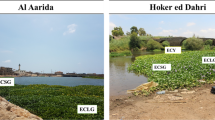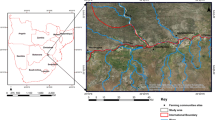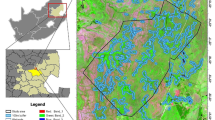Abstract
Streams represent an essential component of functional ecosystems and serve as sensitive indicators of disturbance. Accurate mapping and monitoring of these features is therefore critical, and this study explored the potential to characterize aquatic habitat with remotely sensed data. High spatial resolution, hyperspectral imagery of the Lamar River, Wyoming, USA, was used to examine the relationship between spectrally defined classes and field-mapped habitats. Advantages of this approach included enhanced depiction of fine-scale heterogeneity and improved portrayal of gradational zones between adjacent features. Certain habitat types delineated in the field were strongly associated with specific image classes, but most included areas of diverse spectral character; spatially buffering the field map polygons strengthened this association. Canonical discriminant analysis (CDA) indicated that the ratio of the variability among groups to that within a group was an order of magnitude greater for spectrally defined image classes (20.84) than for field-mapped habitat types (1.82), suggesting that unsupervised image classification might more effectively categorize the fluvial environment. CDA results also suggested that shortwave-infrared wavelengths were valuable for distinguishing various in-stream habitats. Although hyperspectral stream classification seemed capable of identifying more features than previously recognized, the technique also suggested that the intrinsic complexity of the Lamar River would preclude its subdivision into a discrete number of classes. Establishing physically based linkages between observed spectral patterns and ecologically relevant channel characteristics will require additional research, but hyperspectral stream classification could provide novel insight into fluvial systems while emerging as a potentially powerful tool for resource management.






Similar content being viewed by others
References
A. M. Alabyan R. S. Chalov (1998) ArticleTitleTypes of river channel patterns and their natural controls. Earth Surface Processes and Landforms 23 467–474 Occurrence Handle10.1002/(SICI)1096-9837(199805)23:5<467::AID-ESP861>3.0.CO;2-T
P. A. Bisson J. L. Nielsen R. A. Palmason L. E. Grove (1982) A system of naming habitat types in small streams, with examples of habitat utilization by salmonids during low streamflow. N. A. Armatrout (Eds) Acquisition and utilization of aquatic habitat inventory information. American Fisheries Society Bethesda, Maryland 62–73
P. J. Boon (1992) Essential elements in the case for river conservation. P. J. Boon P. Calow G. E. Petts (Eds) River conservation and management. John Wiley & Sons Chichester, UK 11–33
R. P. Bukata J. H. Jerome K. Y. Kondratyev D. V. Pozdnyakov (1995) Optical properties and remote sensing of inland and coastal waters. CRC Press Boca Raton, Florida 362
P. A. Burrough (1996) Natural objects with indeterminate boundaries. P. A. Burrough A. U. Frank (Eds) Geographic objects with indeterminate boundaries. Taylor and Francis Bristol, Pennsylvania 3–28
B. S. Everitt G. Dunn (1991) Applied multivariate data analysis. Halsted Press New York 304
R. A. Fisher (1936) ArticleTitleThe use of multiple measurements on taxonomic problems. Annals of Eugenics 7 179–188
A. U. Frank (1996) The prevalence of objects with sharp boundaries in GIS. P. A. Burrough A. U. Frank (Eds) Geographic objects with indeterminate boundaries. Taylor and Francis Bristol, Pennsylvania 29–40
C. A. Frissell W. J. Liss C. E. Warren M. D. Hurley (1986) ArticleTitleA hierarchical framework for stream habitat classification: viewing streams in a watershed context. Environmental Management 10 199–214
D. J. Gilvear S. J. Winterbottom (1992) ArticleTitleChannel change and flood events since 1783 on the regulated River Tay, Scotland: implications for flood hazard management. Regulated Rivers: Research & Management 7 247–260
D. J. Gilvear T. M. Waters A. M. Milner (1995) ArticleTitleImage analysis of aerial photography to quantify changes in channel morphology and in-stream habitat following placer mining in interior Alaska. Freshwater Biology 34 389–398
C. N. Goodwin (1999) Fluvial classification: Neanderthal necessity or needless normalcy. D. S. Olson J. P. Potyondy (Eds) Wildland hydrology. American Water Resources Association Middleburg, Virginia 229–236
T. B. Hardy P. C. Anderson M. U. Neale D. K. Stevens (1994) Applications of multispectral videography for the delineation of riverine depths and mesoscale hydraulic features. R. Marston V. Hasfurther (Eds) Effects of human-induced change on hydrologic systems. American Water Resources Association Bethesda, Maryland 445–454
C. P. Hawkins J. L. Kershner P. A. Bisson M. D. Bryant L. M. Decker S. V. Gregory D. A. McCullough C. K. Overton G. H. Reeves R. J. Steedman M. K. Young (1993) ArticleTitleA hierarchical approach to classifying stream habitat features. Fisheries 18 3–12
H. B. N. Hynes (1975) ArticleTitleThe stream and its valley. Verhandlungen der Internationalen Vereininung fur Theoretische und Angewandte Limnologie 19 1–15
J. R. Jensen (1996) Digital image processing. Prentice-Hall Upper Saddle River, New Jersey 316
J. R. Karr I. J. Schlosser (1978) ArticleTitleWater resources and the land-water interface. Science 201 229–234
H. Kohler (1994) Statistics for business and economics. Harper Collins College Publishers New York 1043
S. C. Ladd W. A. Marcus S. Cherry (1998) ArticleTitleDifferences in trace metal concentrations among fluvial morphologic units and implications for sampling. Environmental Geology 36 259–270 Occurrence Handle10.1007/s002540050341 Occurrence Handle1:CAS:528:DyaK1MXitFSisLo%3D
C. J. Legleiter W. A. Marcus R. L. Lawrence (2002) ArticleTitleEffects of sensor resolution on mapping in-stream habitats. Photogrammetric Engineering and Remote Sensing 68 801–807
J. G. Lyon R. S. Lunetta D. C. Williams (1992) ArticleTitleAirborne multispectral scanner data for evaluating bottom sediment types and water depths of the St. Mary’s River, Michigan. Photogrammetric Engineering and Remote Sensing 58 951–956
D. R. Lyzenga (1981) ArticleTitleRemote sensing of bottom reflectance and water attenuation parameters in shallow water using aircraft and landsat data. International Journal of Remote Sensing 2 71–82
W. A. Marcus (2002) ArticleTitleMapping of stream microhabitats with high spatial resolution hyperspectral imagery. Journal of Geographical Systems 4 113–126 Occurrence Handle10.1007/s101090100078
Marcus, W. A., C. J. Legleiter, R. Aspinall, J. W. Boardman, and R. Crabtree (2003) High spatial resolution, hyperspectral (HSRH) mapping of in-stream habitats, depths, and woody debris in mountain streams. Geomorphology 55: 363–380
S. Maritorena (1996) ArticleTitleRemote sensing of the water attenuation in coral reefs: a case study in French Polynesia. International Journal of Remote Sensing 17 155–166
L. A. K. Mertes (2002) ArticleTitleRemote sensing of riverine landscapes. Freshwater Biology 47 799–816 Occurrence Handle10.1046/j.1365-2427.2002.00909.x
G. A. Meyer S. G. Wells A. J. T. Jull (1995) ArticleTitleFire and alluvial chronology in Yellowstone National Park: climatic and intrinsic controls on Holocene geomorphic processes. Bulletin of the Geological Society of America 107 1211–1230 Occurrence Handle10.1130/0016-7606(1995)107<1211:FAACIY>2.3.CO;2
E. J. Milton D. J. Gilvear I. Hooper (1995) Investigating change in fluvial systems using remotely sensed data. A. Gurnell G. Petts (Eds) Changing river channels John Wiley & Sons New York 277–299
G. W. Minshall C. T. Robinson D. E. Lawrence (1997) ArticleTitlePostfire responses of lotic ecosystems in Yellowstone National Park, U.S.A. Canadian Journal of Fisheries and Aquatic Sciences 54 2509–2525 Occurrence Handle10.1139/cjfas-54-11-2509
D. R. Montgomery J. M. Buffington (1997) ArticleTitleChannel-reach morphology in mountain drainage basins. The Geological Society of America Bulletin 109 596–612 Occurrence Handle10.1130/0016-7606(1997)109<0596:CRMIMD>2.3.CO;2
J. A. Moody D. A. Martin (2001) ArticleTitleInitial hydrologic and geomorphic response following a wildfire in the Colorado Front Range. Earth Surface Processes and Landforms 26 1049–1070
E. Muller H. Decamps M. K. Dobson (1993) ArticleTitleContribution of space remote sensing to river studies. Freshwater Biology 29 301–312
W. D. Philpot (1989) ArticleTitleBathymetric mapping with passive multispectral imagery. Applied Optics 28 1569–1578
Pierce, K. L. (1979) History and dynamics of glaciation in the northern Yellowstone National Park area. US Geological Survey Professional Paper 729-F. Government Printing Office, Washington, DC, 90 pp
G. C. Poole C. A. Frissell S. C. Ralph (1997) ArticleTitleIn-stream habitat unit classification: inadequacies for monitoring and some consequences for management. Journal of the American Water Resources Association 33 879–896
J. C. Price (1997) ArticleTitleSpectral band selection for visible-near infrared remote sensing: spectral- spatial resolution tradeoffs. IEEE Transactions on Geoscience and Remote Sensing 35 1277–1299 Occurrence Handle10.1109/36.628794
D. L. Rosgen (1994) ArticleTitleA classification of natural rivers. Catena 22 169–199 Occurrence Handle10.1016/0341-8162(94)90001-9
J. R. Schott (1997) Remote sensing: the image chain approach. Oxford University Press New York 394
R. R. Schumann (1989) ArticleTitleMorphology of Red Creek, Wyoming, an arid-region anastomosing channel system. Earth Surface Processes and Landforms 14 277–288
L. C. Smith (1997) ArticleTitleSatellite remote sensing of river inundation area, stage, and discharge: a review. Hydrological Processes 11 1427–1439 Occurrence Handle10.1002/(SICI)1099-1085(199708)11:10<1427::AID-HYP473>3.3.CO;2-J
Swayze, G. A., R. N. Clark, R. M. Pearson, and K. E. Livo (1996) Mapping acid-generating minerals at the California Gulch Superfund Site in Leadville, Colorado using imaging spectroscopy. Pages 231–234 in Summaries of the sixth annual JPL airborne earth science workshop, volume 1. AVIRIS Workshop, Pasadena, California, 4–8 March 1996
J. V. Ward (1989) ArticleTitleThe four-dimensional nature of lotic ecosystems. Journal of the North American Benthological Society 8 2–8
InstitutionalAuthorNameWater Science and Technology Board. (2002) Riparian areas: functions and strategies for management. National Academy Press Washington, DC 436
R. M. Westaway S. N. Lane D. M. Hicks (2001) ArticleTitleRemote sensing of clear-water, shallow, gravel-bed rivers using digital photogrammetry. Photogrammetric Engineering and Remote Sensing 67 1271–1281 Occurrence Handle1:CAS:528:DC%2BD38XjsFGgug%3D%3D
P. J. Whiting J. B. Bradley (1993) ArticleTitleA process-based classification system for headwater streams. Earth Surface Processes and Landforms 18 603–612
G.P. Williams (1978) The case of the shrinking channels - the North Platte and Platte Rivers in Nebraska. United States Geological Survey Circular 781. Government Printing Office Washington, DC 48
S. J. Winterbottom D. J. Gilvear (1997) ArticleTitleQuantification of channel-bed morphology in gravel-bed rivers using airborne multispectral imagery and aerial photography. Regulated Rivers: Research & Management 13 489–499
E. Wohl (2000) Mountain rivers. American Geophysical Union Washington, DC 320
A. Wright W. A. Marcus R. Aspinall (2000) ArticleTitleEvaluation of multispectral, fine scale digital imagery as a tool for mapping stream morphology. Geomorphology 33 107–120 Occurrence Handle10.1016/S0169-555X(99)00117-8
Acknowledgments
Probe-1 data collected in August 1999 was funded by a NASA EOCAP grant (Stennis Space Flight Center, Mississippi) administered through Yellowstone Ecosystem Studies. The map in Figure 1 was developed from a DEM acquired by Intermap Technologies’ Star3i sensor, obtained through a NASA Scientific Data Purchase. The author is indebted to W. Andrew Marcus and Robert L. Crabtree for the opportunity to pursue this project and to David J. Gilvear and Craig N. Goodwin for their thoughtful reviews. Jim Rasmussen and Rob Ahl provided invaluable assistance in the field. Special thanks are also due to Mark Fonstad, Joan Plunkett, and especially Annie Toth, who played a vital role in the evolution of this manuscript.
Author information
Authors and Affiliations
Corresponding author
Rights and permissions
About this article
Cite this article
Legleiter, C. Spectrally Driven Classification of High Spatial Resolution, Hyperspectral Imagery: A Tool for Mapping In-Stream Habitat . Environmental Management 32, 399–411 (2003). https://doi.org/10.1007/s00267-003-0034-1
Published:
Issue Date:
DOI: https://doi.org/10.1007/s00267-003-0034-1




